Resume
Carpenter Cover Letter Examples

May 29, 2025
|
12 min read
Crafting a cover letter with precision: Nail your next carpenter job application by writing a compelling letter that builds on your woodworking skills and opens doors to new opportunities. Follow our tips and avoid getting hammered!
4.70 Average rating
Rated by 348 people
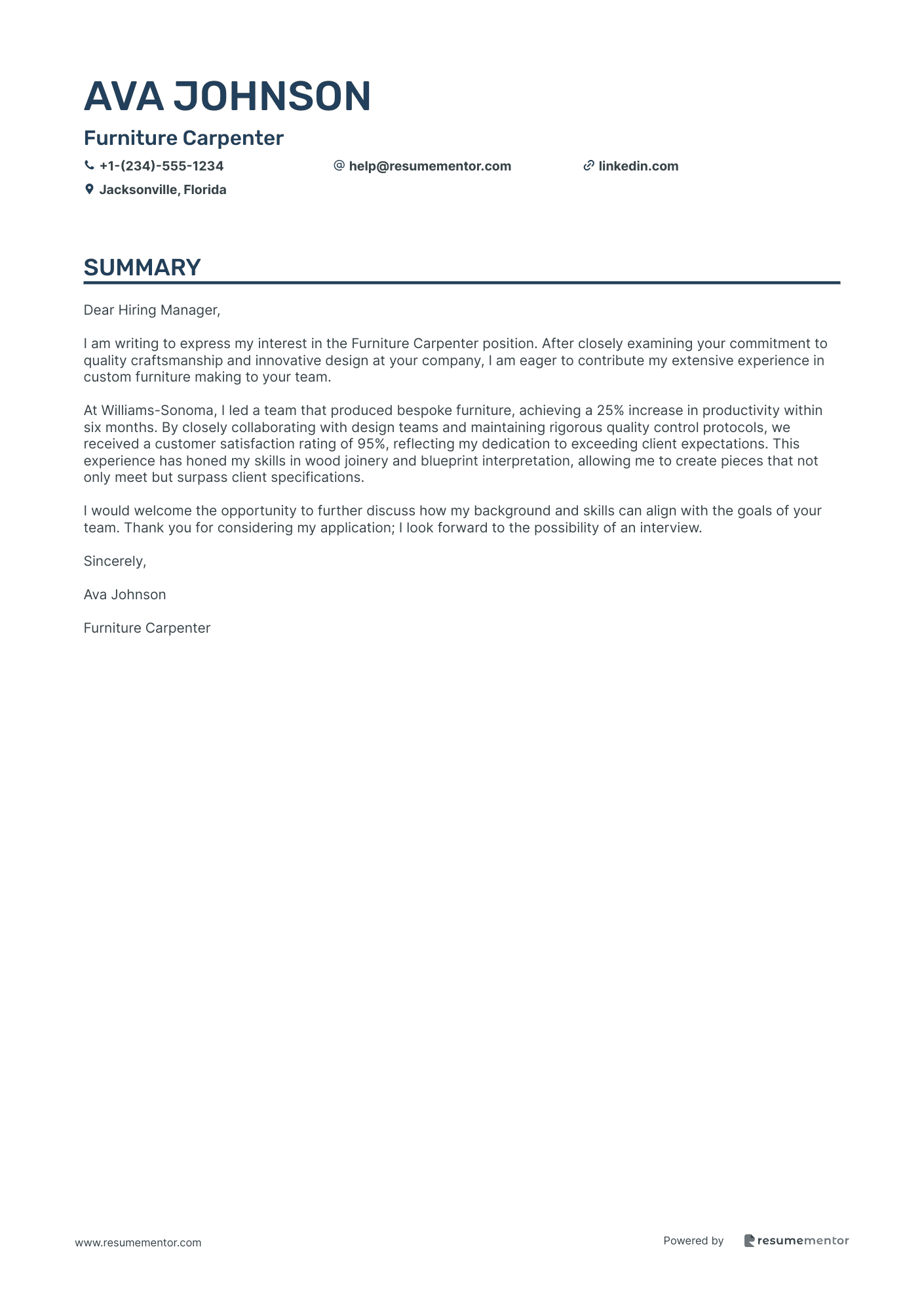
Furniture Carpenter
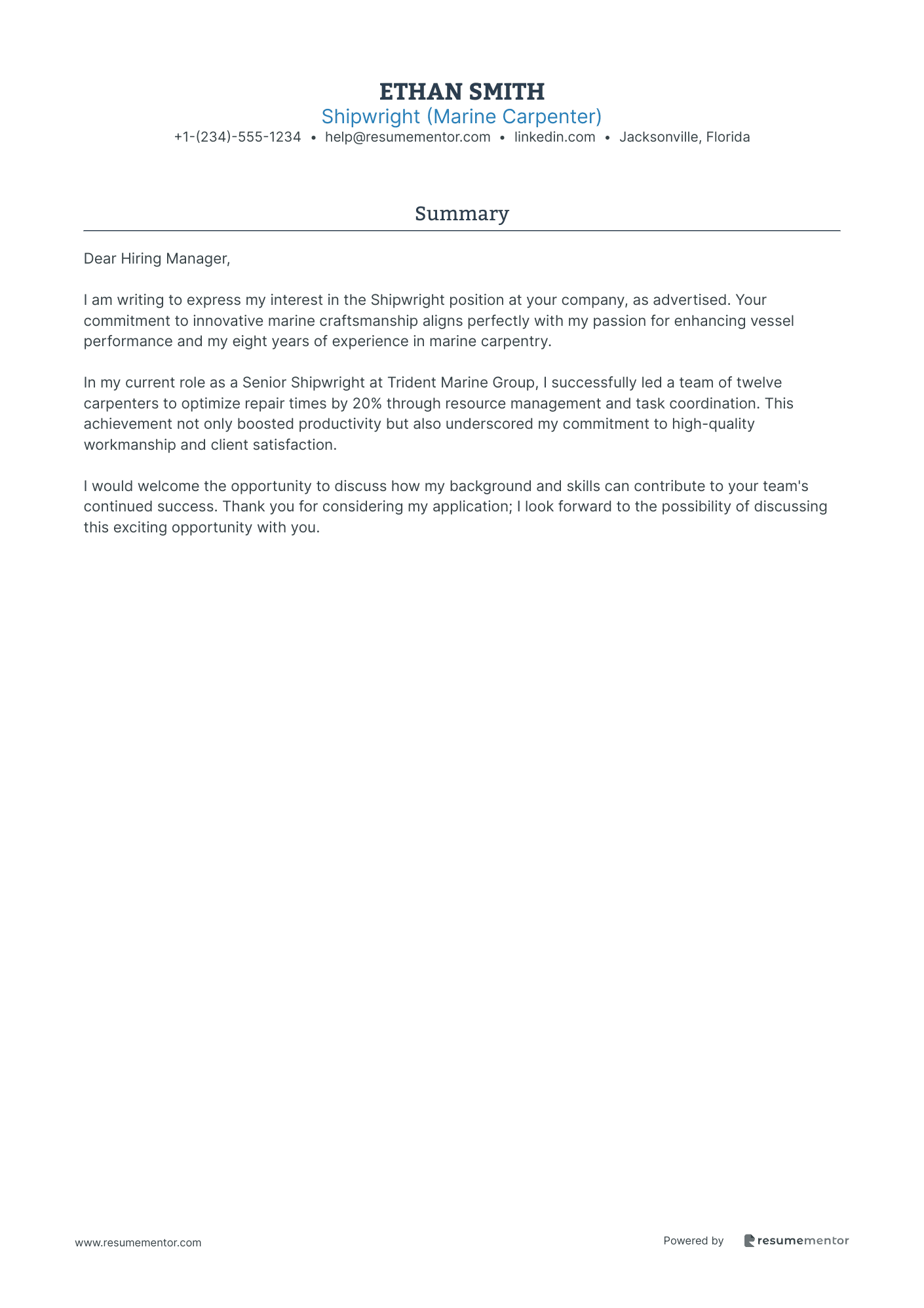
Shipwright (Marine Carpenter)
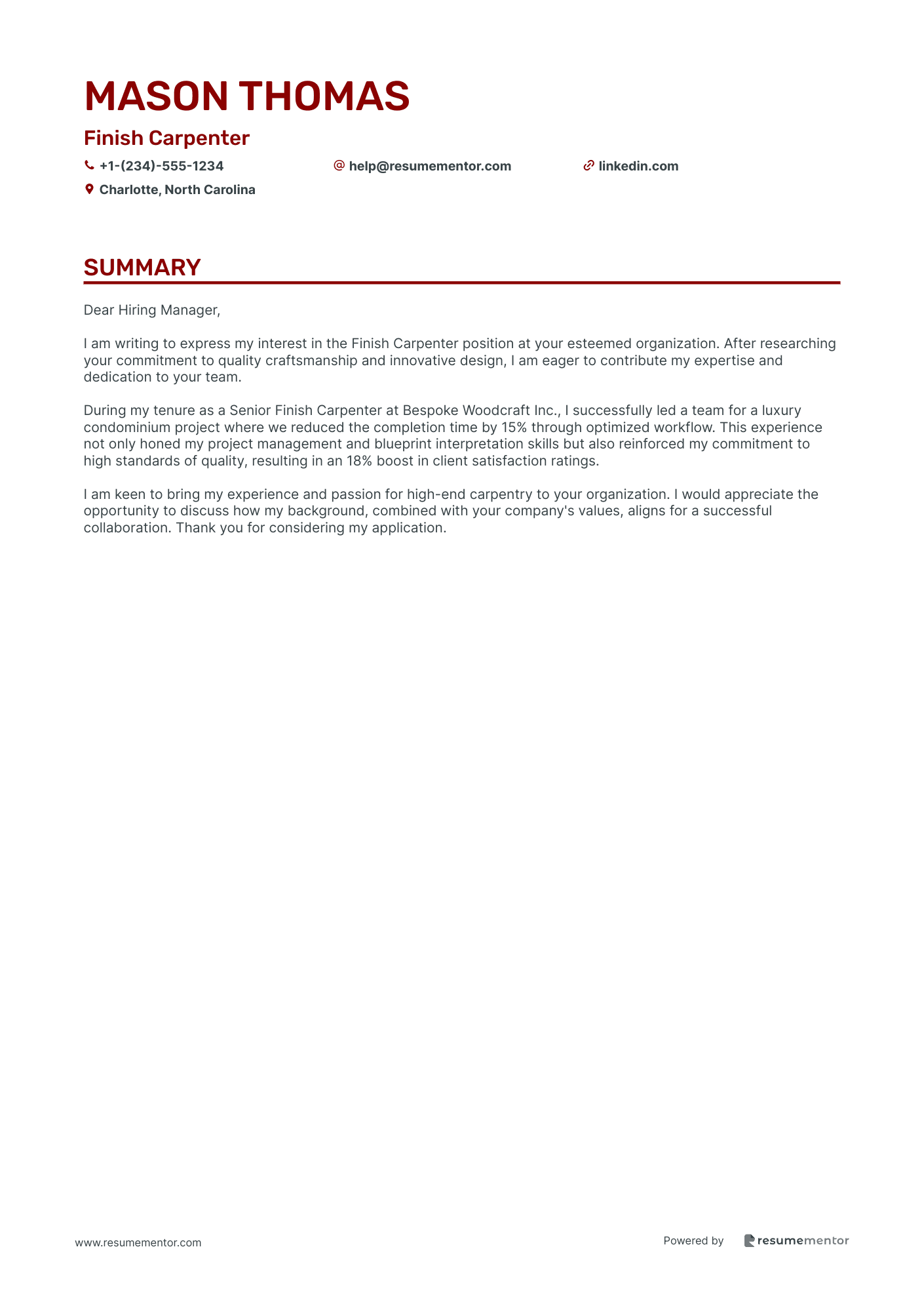
Finish Carpenter
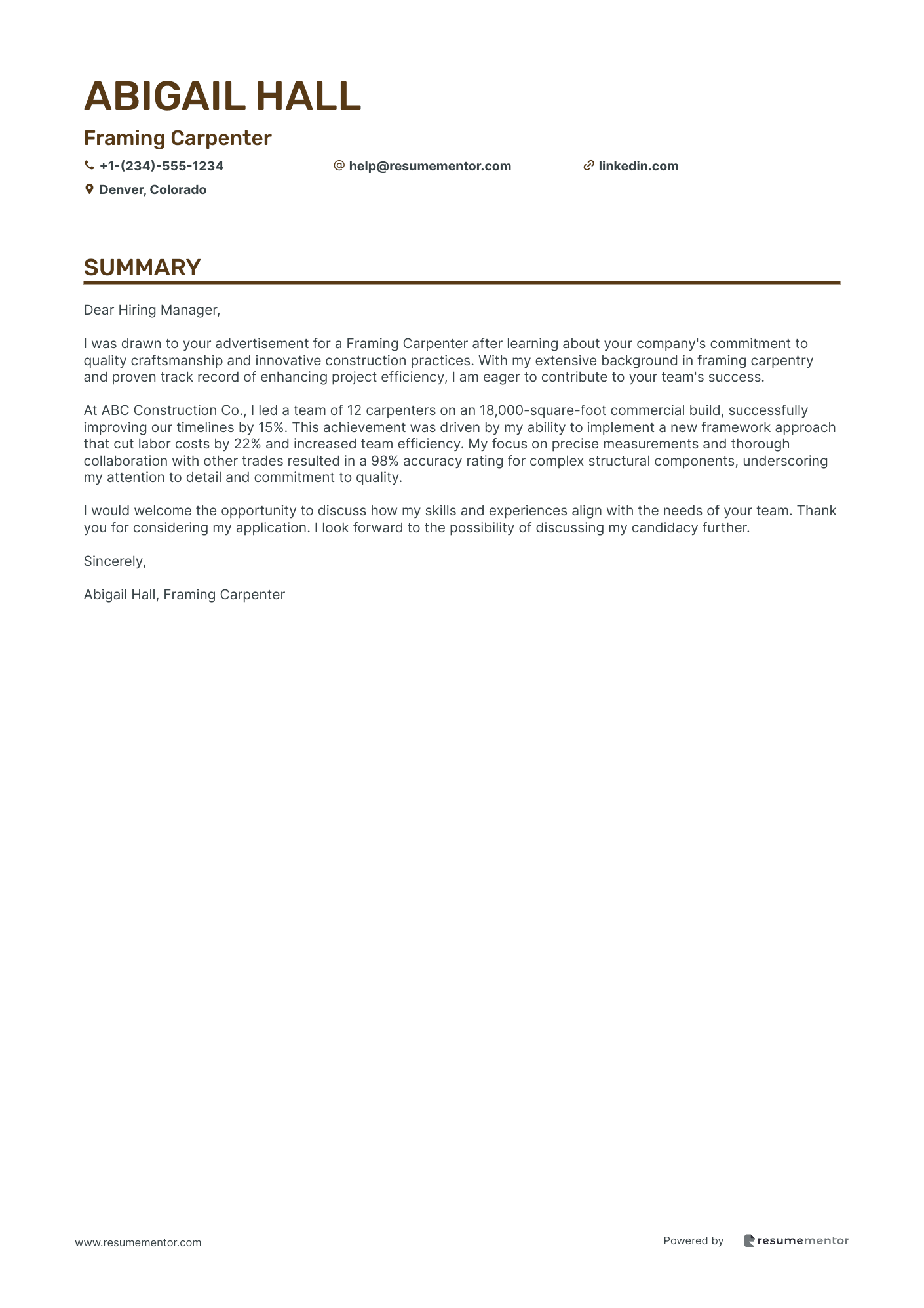
Framing Carpenter
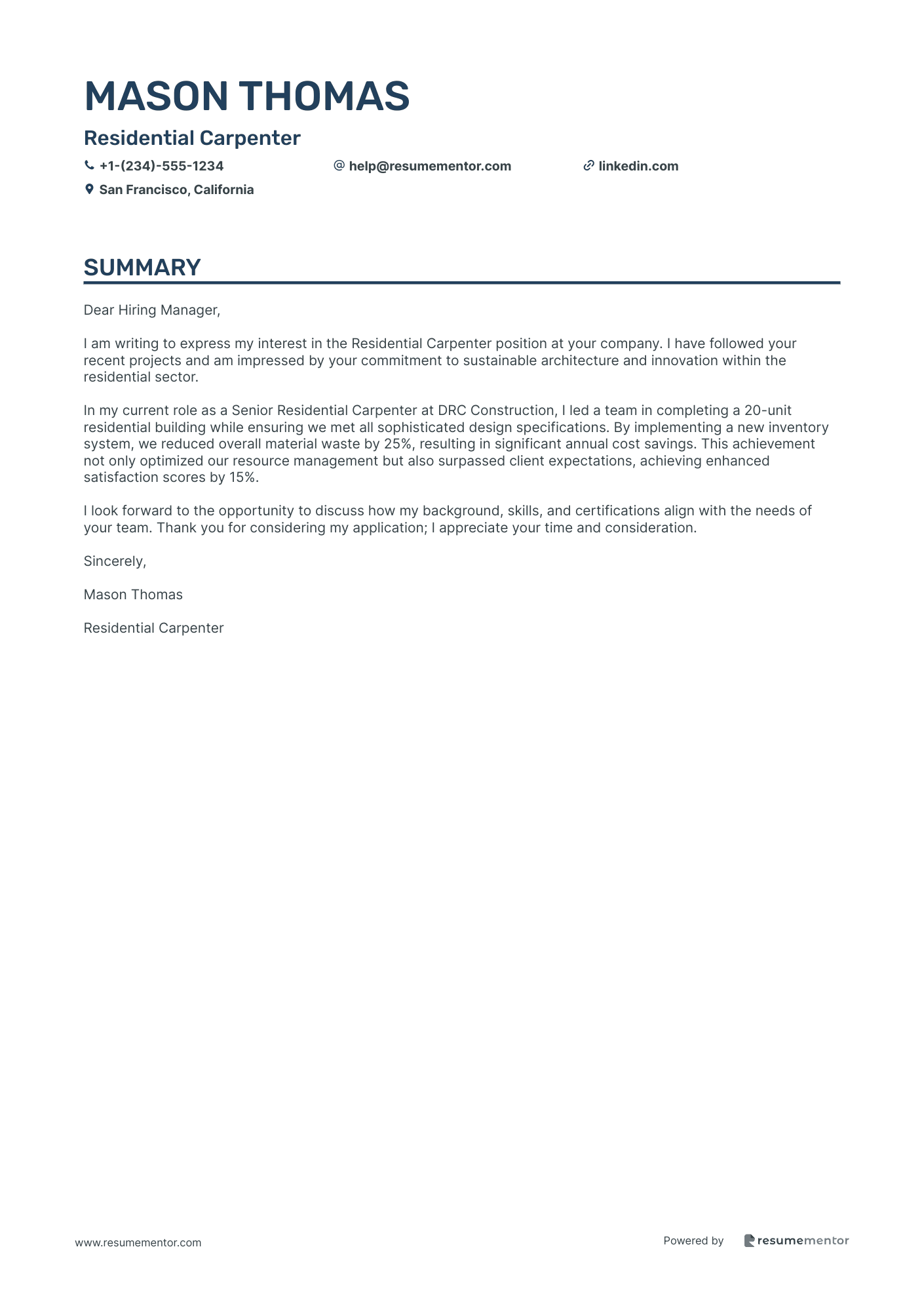
Residential Carpenter
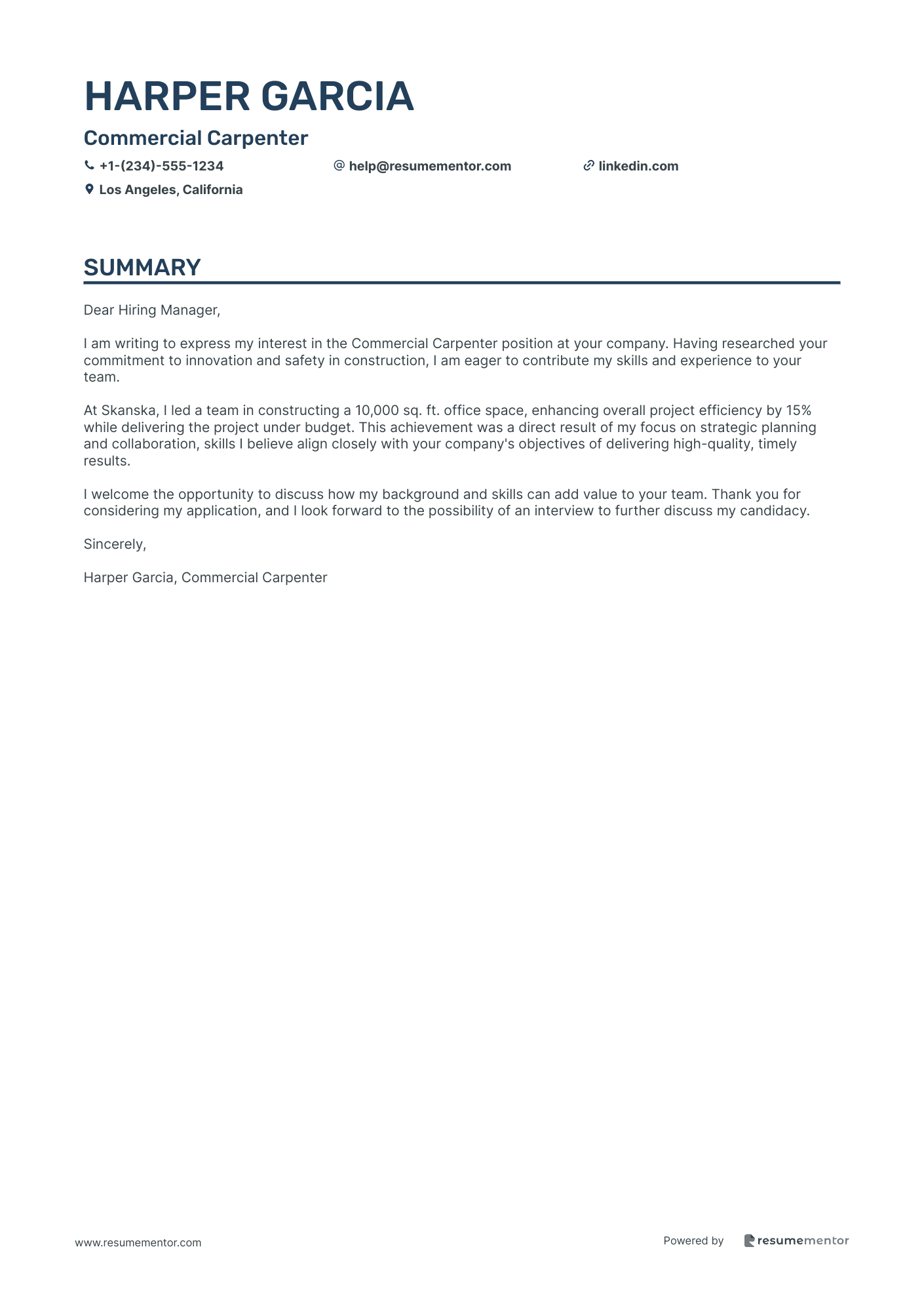
Commercial Carpenter
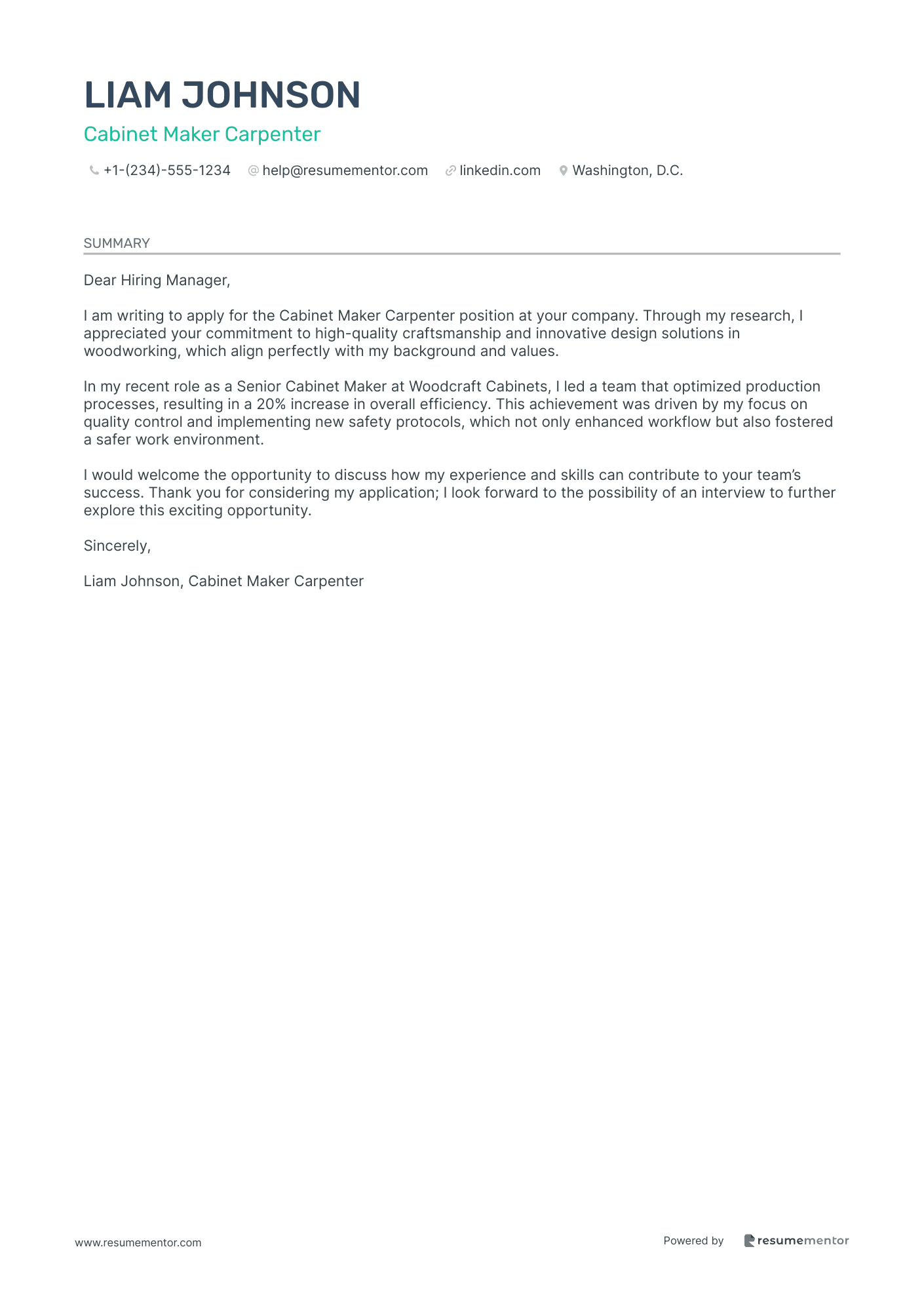
Cabinet Maker Carpenter
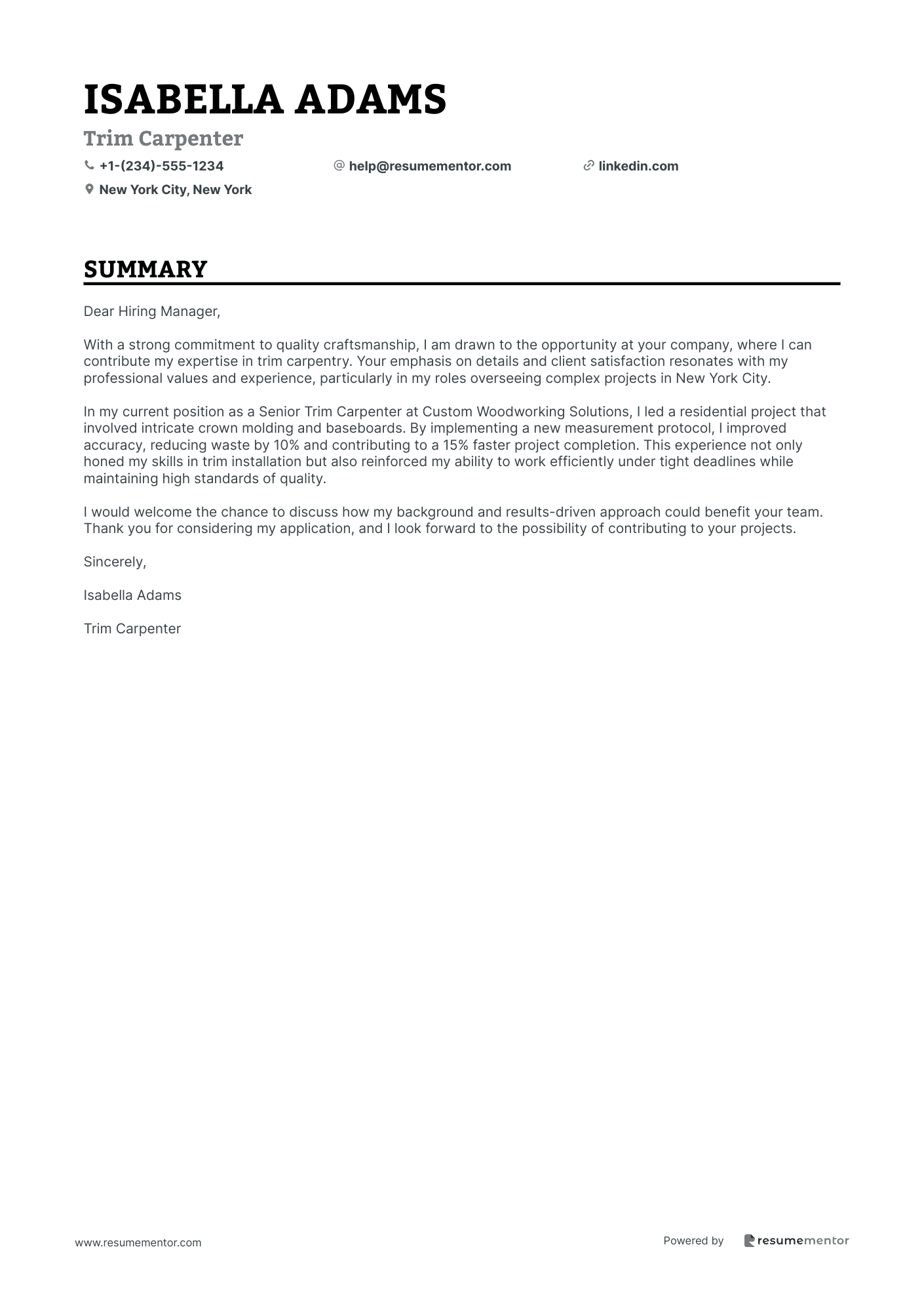
Trim Carpenter
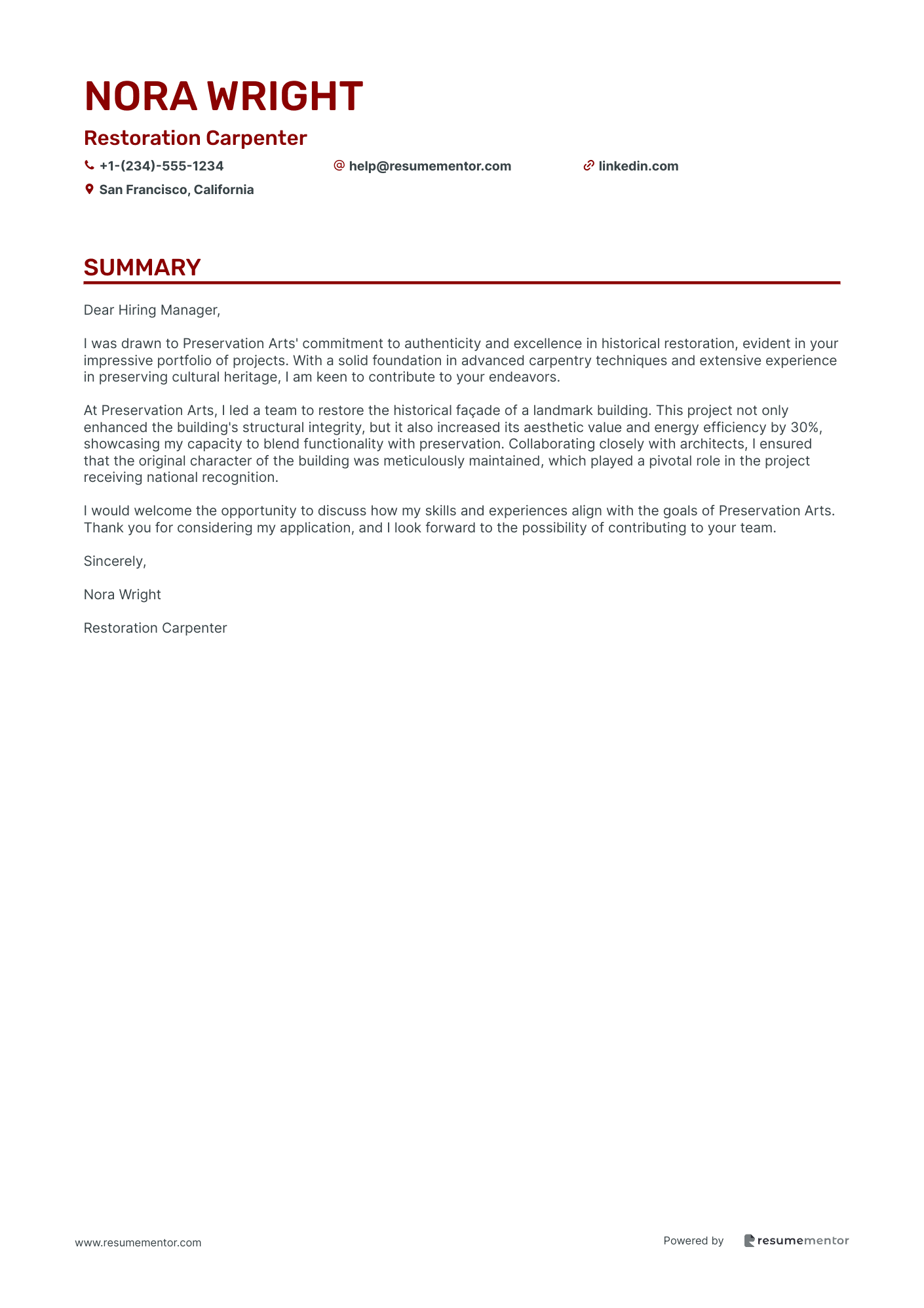
Restoration Carpenter
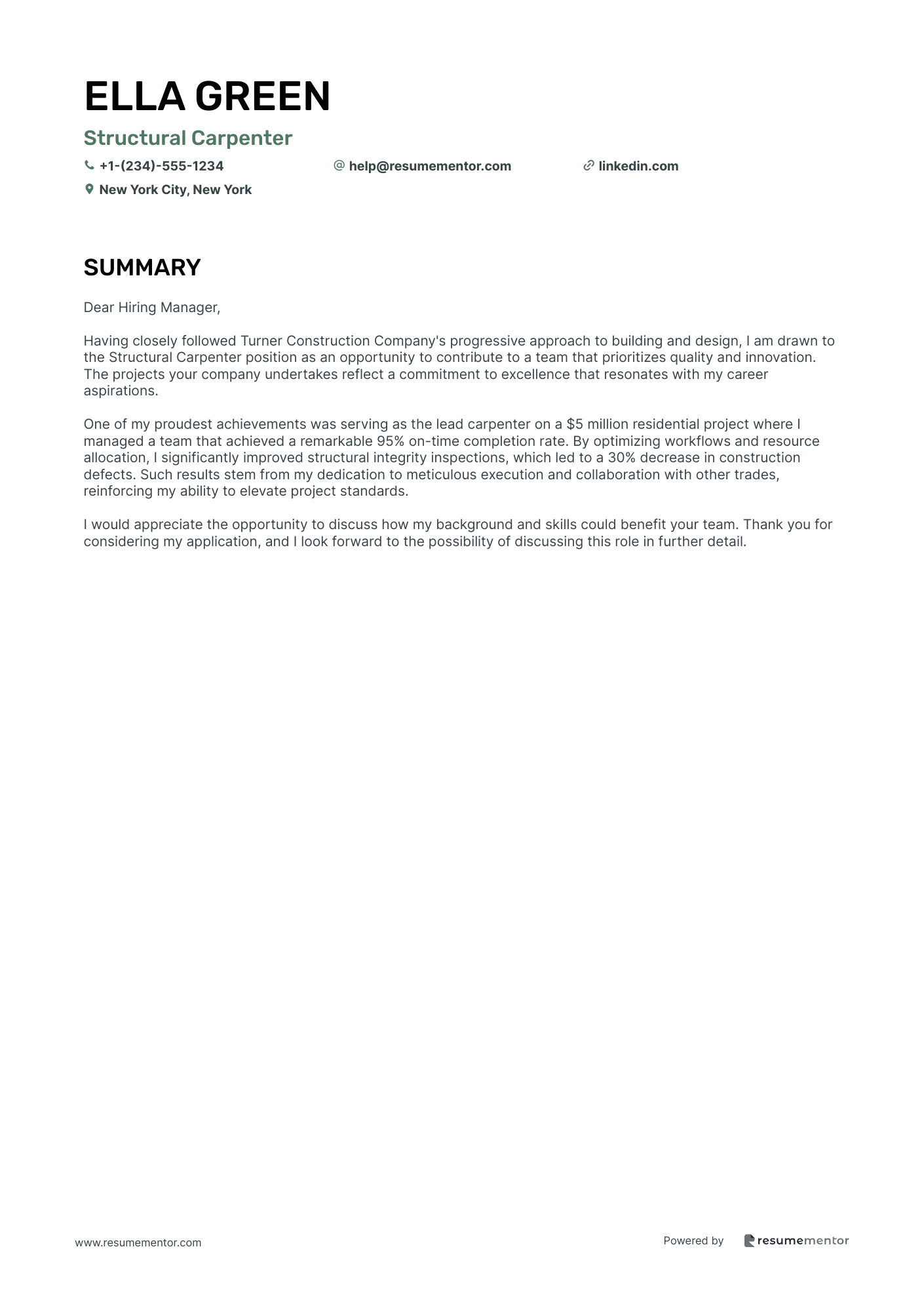
Structural Carpenter

Furniture Carpenter cover letter sample
When applying for this position, it’s important to showcase any previous woodworking or furniture-making experience. Mention specific skills like measuring, cutting, and sanding, as precision is key in this field. Highlight any relevant training or certifications, such as carpentry courses, and include the duration for credibility. Provide examples of projects you’ve completed, detailing your role in the process from design to finish. Use a 'skill-action-result' approach to demonstrate how your craftsmanship has improved client satisfaction or increased sales for past employers.
Ava Johnson
Furniture Carpenter
Summary
Dear Hiring Manager,
I am writing to express my interest in the Furniture Carpenter position. After closely examining your commitment to quality craftsmanship and innovative design at your company, I am eager to contribute my extensive experience in custom furniture making to your team.
At Williams-Sonoma, I led a team that produced bespoke furniture, achieving a 25% increase in productivity within six months. By closely collaborating with design teams and maintaining rigorous quality control protocols, we received a customer satisfaction rating of 95%, reflecting my dedication to exceeding client expectations. This experience has honed my skills in wood joinery and blueprint interpretation, allowing me to create pieces that not only meet but surpass client specifications.
I would welcome the opportunity to further discuss how my background and skills can align with the goals of your team. Thank you for considering my application; I look forward to the possibility of an interview.
Sincerely,
Ava Johnson
Furniture Carpenter
Shipwright (Marine Carpenter) cover letter sample
When applying for this position, it’s important to showcase your hands-on experience with woodworking and familiarity with marine materials. Highlight any certifications in safety protocols or specialized techniques. Mention projects where you successfully built or repaired vessels, focusing on your craftsmanship and attention to detail. Use the 'skill-action-result' method to illustrate your contributions. For example, describe how your work improved the performance or longevity of a vessel. Attention to deadlines and teamwork in a collaborative environment are also essential points to emphasize.
Ethan Smith
Shipwright (Marine Carpenter)
Summary
Dear Hiring Manager,
I am writing to express my interest in the Shipwright position at your company, as advertised. Your commitment to innovative marine craftsmanship aligns perfectly with my passion for enhancing vessel performance and my eight years of experience in marine carpentry.
In my current role as a Senior Shipwright at Trident Marine Group, I successfully led a team of twelve carpenters to optimize repair times by 20% through resource management and task coordination. This achievement not only boosted productivity but also underscored my commitment to high-quality workmanship and client satisfaction.
I would welcome the opportunity to discuss how my background and skills can contribute to your team's continued success. Thank you for considering my application; I look forward to the possibility of discussing this exciting opportunity with you.
Finish Carpenter cover letter sample
When applying for this position, it’s important to showcase your hands-on experience with various materials and tools. Highlight any specialized training or certifications related to carpentry techniques. Discuss your ability to read and interpret blueprints accurately, which demonstrates your attention to detail. Include examples of past projects where your craftsmanship improved aesthetics or functionality. Don’t forget to mention how your work has met deadlines and adhered to safety standards, reflecting your reliability and commitment to quality in every task.
Mason Thomas
Finish Carpenter
Summary
Dear Hiring Manager,
I am writing to express my interest in the Finish Carpenter position at your esteemed organization. After researching your commitment to quality craftsmanship and innovative design, I am eager to contribute my expertise and dedication to your team.
During my tenure as a Senior Finish Carpenter at Bespoke Woodcraft Inc., I successfully led a team for a luxury condominium project where we reduced the completion time by 15% through optimized workflow. This experience not only honed my project management and blueprint interpretation skills but also reinforced my commitment to high standards of quality, resulting in an 18% boost in client satisfaction ratings.
I am keen to bring my experience and passion for high-end carpentry to your organization. I would appreciate the opportunity to discuss how my background, combined with your company's values, aligns for a successful collaboration. Thank you for considering my application.
Framing Carpenter cover letter sample
When applying for this position, it's essential to showcase any prior experience in construction or woodworking. Highlight your knowledge of tools and materials commonly used in framing, such as lumber types and fasteners. Emphasize your understanding of blueprints and how you’ve effectively executed projects based on them. Include specific examples of your work, detailing the scale of projects managed. Demonstrating teamwork skills and safety practices is also critical, as collaboration and adherence to regulations can greatly impact project outcomes and employer trust.
Summary
Dear Hiring Manager,
I was drawn to your advertisement for a Framing Carpenter after learning about your company's commitment to quality craftsmanship and innovative construction practices. With my extensive background in framing carpentry and proven track record of enhancing project efficiency, I am eager to contribute to your team's success.
At ABC Construction Co., I led a team of 12 carpenters on an 18,000-square-foot commercial build, successfully improving our timelines by 15%. This achievement was driven by my ability to implement a new framework approach that cut labor costs by 22% and increased team efficiency. My focus on precise measurements and thorough collaboration with other trades resulted in a 98% accuracy rating for complex structural components, underscoring my attention to detail and commitment to quality.
I would welcome the opportunity to discuss how my skills and experiences align with the needs of your team. Thank you for considering my application. I look forward to the possibility of discussing my candidacy further.
Sincerely,
Abigail Hall, Framing Carpenter
Residential Carpenter cover letter sample
When crafting your cover letter, focus on your hands-on experience in woodworking and construction. Highlight your knowledge of building codes and safety regulations that ensure high-quality work. Mention any formal training or apprenticeships that demonstrate your commitment to the trade. Be sure to provide specific examples of projects you've completed, emphasizing how you met deadlines and stayed within budgets. Use metrics to illustrate your impact, such as the percentage of on-time completions or customer satisfaction ratings, to make a compelling case for your application.
Mason Thomas
Residential Carpenter
Summary
Dear Hiring Manager,
I am writing to express my interest in the Residential Carpenter position at your company. I have followed your recent projects and am impressed by your commitment to sustainable architecture and innovation within the residential sector.
In my current role as a Senior Residential Carpenter at DRC Construction, I led a team in completing a 20-unit residential building while ensuring we met all sophisticated design specifications. By implementing a new inventory system, we reduced overall material waste by 25%, resulting in significant annual cost savings. This achievement not only optimized our resource management but also surpassed client expectations, achieving enhanced satisfaction scores by 15%.
I look forward to the opportunity to discuss how my background, skills, and certifications align with the needs of your team. Thank you for considering my application; I appreciate your time and consideration.
Sincerely,
Mason Thomas
Residential Carpenter
Commercial Carpenter cover letter sample
When crafting your cover letter, emphasize your hands-on experience with wood framing, drywall installation, and finish carpentry. Highlight any proficiency with tools, such as saws and nail guns, and mention safety practices you've adhered to on-site. If you’ve completed any relevant training or certifications, include those details to showcase your expertise. Additionally, provide examples of past projects where your craftsmanship led to increased efficiency or cost savings. Use the 'skill-action-result' framework to demonstrate your contributions to previous employers effectively.
Harper Garcia
Commercial Carpenter
Summary
Dear Hiring Manager,
I am writing to express my interest in the Commercial Carpenter position at your company. Having researched your commitment to innovation and safety in construction, I am eager to contribute my skills and experience to your team.
At Skanska, I led a team in constructing a 10,000 sq. ft. office space, enhancing overall project efficiency by 15% while delivering the project under budget. This achievement was a direct result of my focus on strategic planning and collaboration, skills I believe align closely with your company's objectives of delivering high-quality, timely results.
I welcome the opportunity to discuss how my background and skills can add value to your team. Thank you for considering my application, and I look forward to the possibility of an interview to further discuss my candidacy.
Sincerely,
Harper Garcia, Commercial Carpenter
Cabinet Maker Carpenter cover letter sample
When applying for this position, it’s essential to showcase any previous experience in woodworking or related fields. Highlight your mastery of tools and machinery, particularly the use of chisels, saws, and routers. If you’ve completed training in design software like AutoCAD, make sure to mention it, as it underscores your technical skills. Provide concrete examples of projects you’ve worked on, detailing how your craftsmanship improved functionality or aesthetics. Use a 'skill-action-result' framework to demonstrate how your contributions led to successful outcomes in previous roles.
Liam Johnson
Cabinet Maker Carpenter
Summary
Dear Hiring Manager,
I am writing to apply for the Cabinet Maker Carpenter position at your company. Through my research, I appreciated your commitment to high-quality craftsmanship and innovative design solutions in woodworking, which align perfectly with my background and values.
In my recent role as a Senior Cabinet Maker at Woodcraft Cabinets, I led a team that optimized production processes, resulting in a 20% increase in overall efficiency. This achievement was driven by my focus on quality control and implementing new safety protocols, which not only enhanced workflow but also fostered a safer work environment.
I would welcome the opportunity to discuss how my experience and skills can contribute to your team’s success. Thank you for considering my application; I look forward to the possibility of an interview to further explore this exciting opportunity.
Sincerely,
Liam Johnson, Cabinet Maker Carpenter
Trim Carpenter cover letter sample
Highlight your experience with precise measurements and cutting techniques. Mention your familiarity with various materials like wood, MDF, or plywood. If you have completed projects that involved custom fittings or intricate designs, include those details. Talk about your ability to read blueprints and technical drawings, as this is essential. Showcase problem-solving skills in resolving issues on-site. Additionally, describe how your craftsmanship has resulted in safety and aesthetic improvements in previous work. Use a 'skill-action-result' approach to emphasize your contributions.
Isabella Adams
Trim Carpenter
Summary
Dear Hiring Manager,
With a strong commitment to quality craftsmanship, I am drawn to the opportunity at your company, where I can contribute my expertise in trim carpentry. Your emphasis on details and client satisfaction resonates with my professional values and experience, particularly in my roles overseeing complex projects in New York City.
In my current position as a Senior Trim Carpenter at Custom Woodworking Solutions, I led a residential project that involved intricate crown molding and baseboards. By implementing a new measurement protocol, I improved accuracy, reducing waste by 10% and contributing to a 15% faster project completion. This experience not only honed my skills in trim installation but also reinforced my ability to work efficiently under tight deadlines while maintaining high standards of quality.
I would welcome the chance to discuss how my background and results-driven approach could benefit your team. Thank you for considering my application, and I look forward to the possibility of contributing to your projects.
Sincerely,
Isabella Adams
Trim Carpenter
Restoration Carpenter cover letter sample
When crafting your cover letter, focus on your experience in restoration or remodeling projects. Highlight your familiarity with various materials, tools, and techniques specific to the job. Mention any certifications or training you’ve received in carpentry or woodworking. Emphasize your problem-solving abilities by providing examples of past projects where you overcame challenges. Detail how your craftsmanship led to improved aesthetics or structural integrity in previous work. This approach shows your practical skills and dedication, making your application stand out.
Nora Wright
Restoration Carpenter
Summary
Dear Hiring Manager,
I was drawn to Preservation Arts' commitment to authenticity and excellence in historical restoration, evident in your impressive portfolio of projects. With a solid foundation in advanced carpentry techniques and extensive experience in preserving cultural heritage, I am keen to contribute to your endeavors.
At Preservation Arts, I led a team to restore the historical façade of a landmark building. This project not only enhanced the building's structural integrity, but it also increased its aesthetic value and energy efficiency by 30%, showcasing my capacity to blend functionality with preservation. Collaborating closely with architects, I ensured that the original character of the building was meticulously maintained, which played a pivotal role in the project receiving national recognition.
I would welcome the opportunity to discuss how my skills and experiences align with the goals of Preservation Arts. Thank you for considering my application, and I look forward to the possibility of contributing to your team.
Sincerely,
Nora Wright
Restoration Carpenter
Structural Carpenter cover letter sample
When crafting your cover letter, focus on highlighting your experience with framing, roofing, and finishing work. Detail any specialized skills you have, such as working with various materials or operating tools safely and efficiently. If you hold any certifications, like OSHA safety training, be sure to include those. Illustrate your problem-solving abilities by sharing specific examples where your expertise directly improved a project's quality or efficiency. Use a 'task-action-result' framework to demonstrate how your contributions have positively impacted past projects and teams.
Ella Green
Structural Carpenter
Summary
Dear Hiring Manager,
Having closely followed Turner Construction Company's progressive approach to building and design, I am drawn to the Structural Carpenter position as an opportunity to contribute to a team that prioritizes quality and innovation. The projects your company undertakes reflect a commitment to excellence that resonates with my career aspirations.
One of my proudest achievements was serving as the lead carpenter on a $5 million residential project where I managed a team that achieved a remarkable 95% on-time completion rate. By optimizing workflows and resource allocation, I significantly improved structural integrity inspections, which led to a 30% decrease in construction defects. Such results stem from my dedication to meticulous execution and collaboration with other trades, reinforcing my ability to elevate project standards.
I would appreciate the opportunity to discuss how my background and skills could benefit your team. Thank you for considering my application, and I look forward to the possibility of discussing this role in further detail.
Related Articles
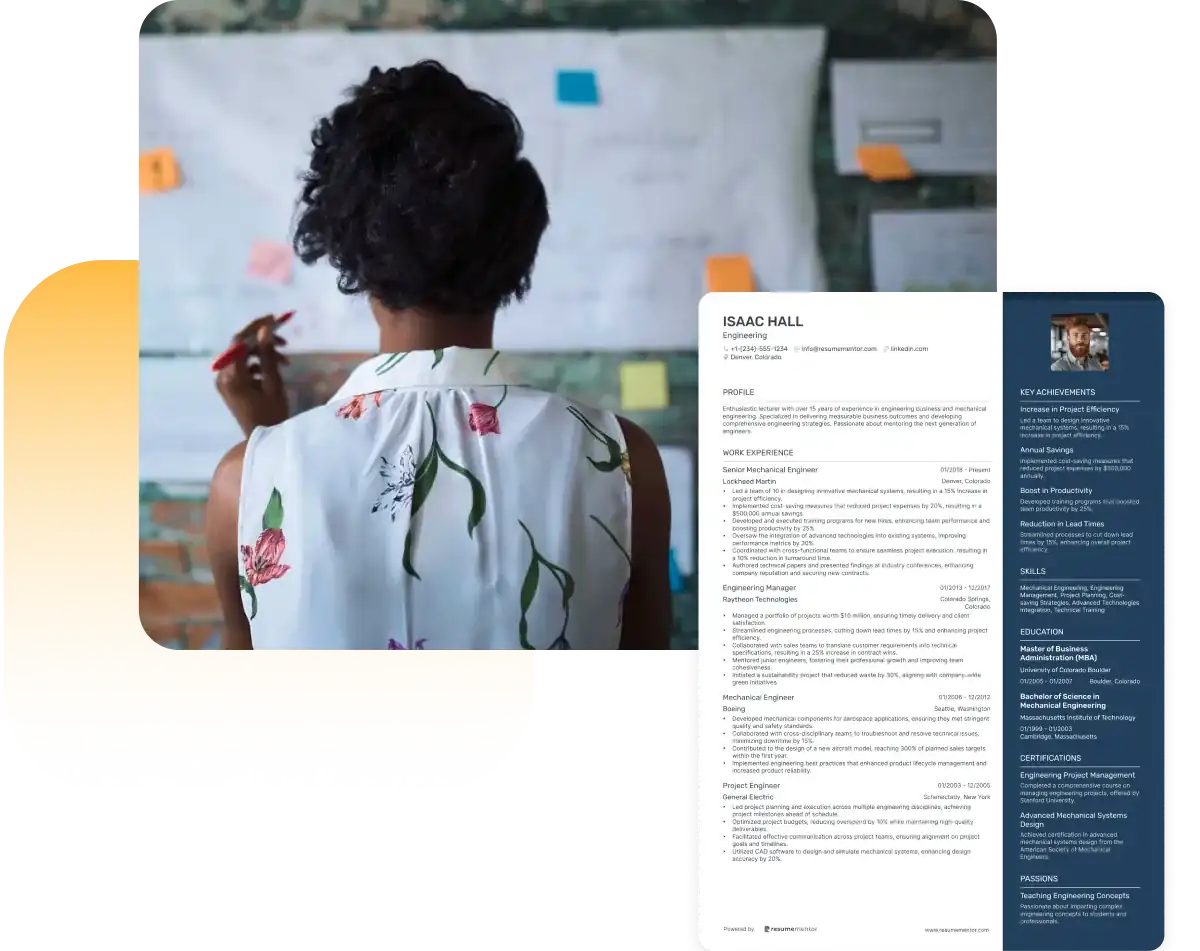
Continue Reading
Check more recommended readings to get the job of your dreams.
Resume
Resources
Tools
© 2025. All rights reserved.
Made with love by people who care.
